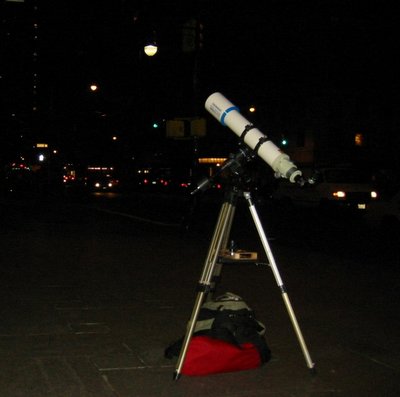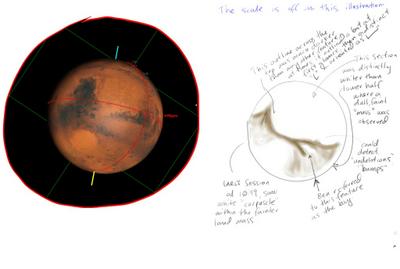Session Name: 20051015.1515
Location: TotL, Central Park, NYC
Site Classification: Urban
Date/time: 15 Oct. 2005, 3:15pm ~ 8:00pm
Handheld Binos: Fuji 7x50
Tripod Mounted Binos: Takahashi 22x60
Transparency/Seeing (1 worst - 5 best): 2.5/3
NELM ~7:15pm NE m4.8 in Cas, 6 * of Little Dipper.
Conditions: Windy. Early it was very hazy, the entire sky overcome by dark clouds, then cleared with so-so transparency and seeing. In the bins, Sun was boiling on the limb, Venus was flaring.
Familiar & pedestrians: "Ice-T", Alexander, Stephen, Derek & Kate, and dozen or more pedestrians
Cardinal point conventions: lower case cardinal directions with respect to Manhattan or abbrev as m-n, -e, -s, -w ; UPPER CASE speaks to celestial equatorial direction, abbrev N, E, S, W.)
************ Remarks ************
After putting in some four hours of work in while Junko & Arissa were having their Saturday Japanese girls' day, I decided to go to TotL for some daytime observing. After eight days of rain I was encouraged by a blue sky with some rolling tufts of clouds. I intended to record our horizon elevation from TotL proper and observe Sun & Venus.
TotL is the central northern tip around the Great Lawn. This is our primary observing spot. Occasionally, we'll observe from TotL-benches. This is on the northeastern corner of the Lawn and the horizon changes dramatically, particularly from an obstructed NE to S. Observing here offers a better SW to N horizon.
I didn't get much done on the surveying. I spent much more time with observing Venus and Sun and showing or talking with the public. In locating Venus from the Sun I was able to mark the azimuth of the foreground trees and elevation of the trees and buildings to m-ssw. A regular that I don't recall his name (Mike?), but one time he said call me "Ice-T", showed up shortly after I set up. Funny thing when seeing these folks during the daytime: I mostly meet them in the dark. So at first I didn't recognize him and it took a few seconds to register. He stayed for a bit, observing and chatting with me and the pedestrians, I asked if he was down at the Belvedere Castle and if saw Ben or Tom, but he hadn't. He eventually left saying he might come back around later in the evening when it was dark. The clouds had been moving in at this time.
Along with the Fujinon 7x50 for handheld and tripod-mounted Tak bins, I brought the Thousand Oaks solar filter that I fit to the Tak bins with rubber bands. I observed and showed to the public Sun and Venus during the day on two occasions. Dark clouds moved in and a few rain drops fell to the ground, but I wouldn’t describe it as a drizzle at all. But it was enough to pack up and sit on the bench reading from 4:25 - 5:40. The weather report called for mostly clear skies so I figured to sit and wait it out. Eventually a large patch of clear sky was seen to the west and that was that. I set up the tripod mounted Taks again to resume observing.
When I returned to observing after a stint on the bench, a young girl and her younger sister rode up on their bikes asking what I was looking at. I told them Venus and the older one asked a lot of questions about color, surface details, and size - all from a 9 or 10 year old. I offered them a look and snapped the tripod down to their size. "Oh too cool! You got to see this." The l'il one looked and echoed her big sister. Their mother was calling from down a bit, and the older shouted back, "Wait! I'm looking at Venus! Come see!" Mom came down and from her bike leaned over to see Venus as well. They all left with repeated thanks as the biked away. Later another pair of youngsters, brother and sister, took a look a Venus. There reactions were more subdued than the pair earlier.
Days (or nights) like this where I don't have many objects logged I feel as if I didn't get enough of my share. I think perhaps that my skill level could be cause. But I am reminded about appreciating the quality of observing one can experience by a thread I recently read in SPA.
Soon after discovering davep's astronomy blog by an email from Ben, I meandered over to Society for Popular Astronomy (SPA) where Dave mentions it. I don't recall specifically which thread it is but there is a dialogue about sketching. In one his posts, Dave speaks of the amount of time he spends on an object, thus, limiting the number of objects observed. I can totally relate to this, but as he, and many others state, what one sees under this kind of study increases the detail seen and ultimately the observation considerably.
[Correction: The comment is from Jeff Stevens.
Jeff Stevens comment on SPA links to the thread I learned from an article, "Drawing Templates" in the
Tools section of Dave's astronomy website. Jeff speaks of improved observing skills and "...slows the observing session down..." I can7t agree more.]
************ Observations ************
Daytime Objects [EDT]
- Venus [15:28, 17:45]
I have been observing Venus in the daytime since late June. It has always impressed me as a waning gibbous phase, but today's observation it looked more like last quarter. It was something like 11" in size then. Today it nearly 21", and coincidentally, Mars is about 19.5". Over this past month or so, both planets have been growing larger by the day, almost in synchronous concert.
- Sun [15:54]
Only one sun spot was observed. It was located about 9:30 on the disk. It was very dark, no penumbra, and appeared as one spot.
- Mercury & Jupiter [17:40]
I wanted to observe Mercury but was unable to detect it. I had worked off the landmarks I had established from the Sun's position earlier. There is a building with two towers and spires atop that was sort of in the way, I estimated their elevation to 6 ~ 6.5°. Mercury should have been right above the m-e tower but I didn't see it. With a low ecliptic, the anticipated path was not promising. I assumed that there was a small window of opportunity to spot it. I began looking for Mercury while Sun was 5.2° high until it set behind the trees and even till sunset. Never did see it.
For sh%ts & giggles, I tried for Jupiter. At the time, between 1750 and 1825, Jupiter was to have been just above the treetop level, about 4°. This part of the sky was much brighter than where I was looking for Venus that I gave up after a few quick scans across the treetops. When the sunset, Stephen mentioned how the sky had a pretty the tangerine color.
Evening Objects
- Moon [19:30]
On my way out of the park, I noticed the large bright Moon shining through the trees. I decided to set up the bins on the western side of the Lawn to quickly observe it. Instead I spent about a half hour, sketching and appreciating its presence. The most immediate impressions were all the rays shooting across the surface of a ~12.5 day Moon. One can really get a feeling of her sphericity by tracing the shallow arcing lines across her face.
I mostly concentrated on the gross features of Moon and her eastern limb. Apparently, libration was favorable for this section as I was able to see Mare Humboldtianum, Mare Marginis, and Mare Smythii. Mare Undarum and Mare Spumans were dark and bold extending NE from Mare Fecunditatis, east of line between Mare Crisium and Mare Tranquillitatis. Mare Undarum always strikes me as a "3" or an "M". Mare Fecunditatis has a rectangular appearance. Dark floor crater Condorcet easily stood out in contrast to the surrounding area. Just above the NNE rim of Mare Crisium, Mare Anguis was apparent with dark floor, though not as striking as the Undarum or Spumans off the SSE rim, nor as large as Spumans.
West of Mare Crisium, Proclus was really packing a punch in brightness, absolutely the brightest and whitest object that impressed me. I don't recall noticing Aristarchus. Interesting about Proclus, is that the rays are in a fan shape to the east, a bit better than 180° around, but they are not visible to the west. Due to its brightness, I would think that this is a 'fresh' crater and rays, but that would make any material above that blanked out section to be more recent. This ray-blanked area obviously has a darker hue to it. Something to look up.
This was my first time identifying Mare Humboldtianum. It may have been there before, but I never noticed it nor looked for it. I am not certain if libration is required to see it, but I was pleased with the *discovery* Nearby, to its SSE was Endymion, a crater which had the past as M. Humboldtianum, in that I paid no attention to it before. However, tonight it was obvious and I would say it compares in size with Plato. It also exhibited a dark floor color similar to Plato.
Speaking of the maria, opposing Mare Crisium is Mare Humorum. They appear as cousins of size and shape. Both suffer from some foreshortening, but their roundness can prevail. Mare Humorum was already east of the morning terminator and Schickard and Phocylides were prominent below. Most of the time, I can identify Schickard very easily but have trouble finding Clavius, which is usually what prompts me to look in this area. My experience is that Clavius does not do well under full illumination, reveling at sunrise or sunset.













